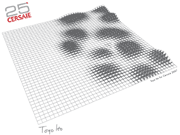The image
Toyo Ito - Cersaie 2007
Grids have ruled space throughout the 20th century.
Cities all over the world have been covered by homogeneous grids.
I have a feeling that in this century, grids will melt, become distorted and transform like natural topographies. In other words, architecture is becoming closer to natural systems.
Toyo Ito was born in 1941. After graduating from the University of Tokyo in 1965, he worked for the Metabolist architect Kiyonori Kikutake until 1969. In 1971 he opened his own office, Urban Robot (URBOT), which was renamed Toyo Ito & Associates, Architects in 1979.
An influential though far from prolific architect, Ito believed that architecture had become encumbered with irrelevant symbolism. In the ‘70s, he sought to erase conventional meaning from his works through minimalist tactics, which is represented in White U (1976) and Silver Hut (1984), inspired by early modernist movements such as Purism and the straightforward use of easily available industrial materials. He developed an aesthetic of lightweight, permeable membranes composed of fabrics, perforated aluminum panels and expanded metal sheets, which he believed was most suited to an increasingly mobile and informal urban lifestyle and designed the projects such as Tower of Winds (1986), Restaurant Nomad (1986) and Yatsushiro Municipal Museum (1991).
Toyo Ito’s main work includes both public and private works. Currently, he is working at various projects in Japan and overseas. Sendai Mediatheque built in 2001 in Sendai, Japan, Ito used a unique structure to compose fluid spaces with hardly any walls. It was received as a sensational project and gave great influence to young architects worldwide. Designing two temporary pavilions in 2002, the Brugge Pavilion in Belgium and the Serpentine Gallery Pavilion 2002 in London, he met the challenge to unify surface and structure. In going beyond the purity of modernism, Toyo Ito is trying to find ways for an architecture of the 21st century: an architecture which reflects nature, emerging from autopoietic processes and organic geometries, creating joyful and pleasant spaces filled with life.
He is currently working on many projects throughout the world, including the Hôpital Cognacq-Jay in Paris, Relaxation Park in Torrevieja, Extension at the Fira de Barcelona, and Montjuic-2 in Barcelona.
In 2006, Ito was awarded the Royal Institute of British Architects Royal Gold Medal.












